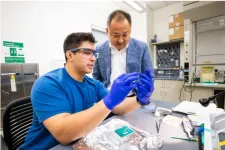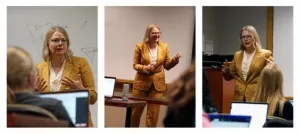(Press-News.org) CAMBRIDGE, MA -- Every cell in the human body contains the same genetic instructions, encoded in its DNA. However, out of about 30,000 genes, each cell expresses only those genes that it needs to become a nerve cell, immune cell, or any of the other hundreds of cell types in the body.
Each cell’s fate is largely determined by chemical modifications to the proteins that decorate its DNA; these modification in turn control which genes get turned on or off. When cells copy their DNA to divide, however, they lose half of these modifications, leaving the question: How do cells maintain the memory of what kind of cell they are supposed to be?
A new MIT study proposes a theoretical model that helps explain how these memories are passed from generation to generation when cells divide. The research team suggests that within each cell’s nucleus, the 3D folding pattern of its genome determines which parts of the genome will be marked by these chemical modifications. After a cell copies its DNA, the marks are partially lost, but the 3D folding allows each daughter cell to easily restore the chemical marks needed to maintain its identity. And each time a cell divides, chemical marks allow a cell to restore its 3D folding of its genome. This way, by juggling the memory between 3D folding and the marks, the memory can be preserved over hundreds of cell divisions.
“A key aspect of how cell types differ is that different genes are turned on or off. It's very difficult to transform one cell type to another because these states are very committed,” says Jeremy Owen PhD ’22, the lead author of the study. “What we have done in this work is develop a simple model that highlights qualitative features of the chemical systems inside cells and how they need to work in order to make memories of gene expression stable.”
Leonid Mirny, a professor in MIT’s Institute for Medical Engineering and Science and the Department of Physics, is the senior author of the paper, which appears today in Science. Former MIT postdoc Dino Osmanović is also an author of the study.
Maintaining memory
Within the cell nucleus, DNA is wrapped around proteins called histones, forming a densely packed structure known as chromatin. Histones can display a variety of modifications that help control which genes are expressed in a given cell. These modifications generate “epigenetic memory,” which helps a cell to maintain its cell type. However, how this memory is passed on to daughter cells is somewhat of a mystery.
Previous work by Mirny’s lab has shown that the 3D structure of folded chromosomes is partly determined by these epigenetic modifications, or marks. In particular, they found that certain chromatin regions, with marks telling cells not to read a particular segment of DNA, attract each other and form dense clumps called heterochromatin, which are difficult for the cell to access.
In their new study, Mirny and his colleagues wanted to answer the question of how those epigenetic marks are maintained from generation to generation. They developed a computational model of a polymer with a few marked regions, and saw that these marked regions collapse into each other, forming a dense clump. Then they studied how these marks are lost and gained.
When a cell copies its DNA to divide it between two daughter cells, each copy gets about half of the epigenetic marks. The cell then needs to restore the lost marks before the DNA is passed to the daughter cells, and the way chromosomes were folded serves as a blueprint for where these remaining marks should go.
These modifications are added by specialized enzymes known as “reader-writer” enzymes. Each of these enzymes is specific for a certain mark, and once they “read” existing marks, they “write” additional marks at nearby locations. If the chromatin is already folded into a 3D shape, marks will accumulate in regions that already had modifications inherited from the parent cell.
“There are several lines of evidence that suggest that the spreading can happen in 3D, meaning if there are two parts that are near each other in space, even if they're not adjacent along the DNA, then spreading can happen from one to another,” Owen says. “That is how the 3D structure can influence the spreading of these marks.”
This process is analogous to the spread of infectious disease, as the more contacts that a chromatin region has with other regions, the more likely it is to be modified, just as an individual who is susceptible to a particular disease is more likely to become infected as their number of contacts increases. In this analogy, dense regions of heterochromatin are like cities where people have many social interactions, while the rest of the genome is comparable to sparsely populated rural areas.
“That essentially means that the marks will be everywhere in the dense region and will be very sparse anywhere outside it,” Mirny says.
The new model suggests possible parallels between epigenetic memories stored in a folded polymer and memories stored in a neural network, he adds. Patterns of marks can be thought of as analogous to the patterns of connections formed between neurons that fire together in a neural network.
“Broadly this suggests that akin to the way neural networks are able to do very complex information processing, the epigenetic memory mechanism we described may be able to process information, not only store it,” he says.
Epigenetic erosion
While this model appeared to offer a good explanation for how epigenetic memory can be maintained, the researchers found that eventually, reader-writer enzyme activity would lead to the entire genome being covered in epigenetic modifications. When they altered the model to make the enzyme weaker, it didn’t cover enough of the genome and memories were lost in a few cell generations.
To get the model to more accurately account for the preservation of epigenetic marks, the researchers added another element: limiting the amount of reader-writer enzyme available. They found that if the amount of enzyme was kept between 0.1 and 1 percent of the number of histones (a percentage based on estimates of the actual abundance of these enzymes), their model cells could accurately maintain their epigenetic memory for up to hundreds of generations, depending on the complexity of the epigenetic pattern.
It is already known that cells begin to lose their epigenetic memory as they age, and the researchers now plan to study whether the process they described in this paper might play a role in epigenetic erosion and loss of cell identity. They also plan to model a disease called progeria, in which cells have a genetic mutation that leads to loss of heterochromatin. People with this disease experience accelerated aging.
“The mechanistic link between these mutations and the epigenetic changes that eventually happen is not well understood,” Owen says. “It would be great to use a model like ours where there are dynamic marks, together with polymer dynamics, to try and explain that.”
The researchers also hope to work with collaborators to experimentally test some of the predictions of their model, which could be done by altering the level of reader-writer enzymes in living cells and measuring the effect on epigenetic memory.
####
The research was funded by the National Human Genome Research Institute, the National Institute of General Medical Sciences, and the National Science Foundation.
END
How cell identity is preserved when cells divide
MIT study suggests 3D folding of the genome is key to cells’ ability to store and pass on “memories” of which genes they should express.
2023-11-16
ELSE PRESS RELEASES FROM THIS DATE:
Liverpool’s chemists awarded Queen’s Anniversary Prize for pioneering research to address global challenges
2023-11-16
The University of Liverpool’s Department of Chemistry has been awarded a prestigious Queen’s Anniversary Prize in recognition of its pioneering research and innovation work to address global challenges and benefit society.
The Queen’s Anniversary Prize is the highest national honour in Higher Education. It is awarded in recognition of world-class excellence and achievement to a small selection of UK institutions every two years.
The Department of Chemistry at the University of Liverpool carries out world-leading research that pushes forward the frontiers of ...
Technique enables AI on edge devices to keep learning over time
2023-11-16
Personalized deep-learning models can enable artificial intelligence chatbots that adapt to understand a user’s accent or smart keyboards that continuously update to better predict the next word based on someone’s typing history. This customization requires constant fine-tuning of a machine-learning model with new data.
Because smartphones and other edge devices lack the memory and computational power necessary for this fine-tuning process, user data are typically uploaded to cloud servers where the model is updated. But data ...
Department of Chemical Engineering receives $3.5 million award to study impact of adolescent exposure to opioids
2023-11-16
Opioid addiction is a pressing public health crisis with far-reaching implications. More than 100,000 deaths a year have been linked to drug overdoses since 2020.
The Centers for Disease Control and Prevention reports that more people died from drug overdoses in 2021 than from firearm and motor vehicle deaths combined. Three-quarters of these overdose deaths were attributable to opioids.
A five-year, $3.5 million grant from the National Institutes of Health’s National Institute on Drug Abuse will fund the Virginia Tech Department of Chemical Engineering’s pioneering research to understand how adolescent ...
Terrorism rather than pandemics more concerning for those with those with authoritarian views, analysis shows
2023-11-16
Those with authoritarian political views are more likely to be concerned about terrorism and border control than a future new health pandemic, new research shows.
During the pandemic, rather than a desire for a stronger government with the ability to impose measures to address the pandemic and its consequences, people with authoritarian views rejected this and embraced individual autonomy.
Researchers analysed public perceptions of security threats in 2012 and in 2020. They believe COVID-19 belongs to a distinct category of threats of which those with authoritarian views are less ...
University of Miami receives $1.8 million NOAA grant to study South Florida’s coastal ecosystems
2023-11-16
The University of Miami Rosenstiel School of Marine, Atmospheric, and Earth Science has been awarded a nearly $1.8 million grant from the National Oceanic and Atmospheric Administration (NOAA) as part of an anticipated four-year, $4.2 million project to support research on the impacts to South Florida’s coastal ecosystems from a multitude of climate change stressors.
The newly funded project, co-led by the University of Miami Rosenstiel School and NOAA’s Atlantic Oceanographic and Meteorological Laboratory (AOML) will focus on climate impacts to South Florida’s coastal and marine ecosystems, including the Florida Keys National Marine Sanctuary ...
USF researchers help reduce lead levels in Madagascar drinking water
2023-11-16
TAMPA, Fla. (Nov. 16, 2023) -- A team of engineers and public health experts from the University of South Florida is helping Toamasina, Madagascar, residents reduce their exposure to lead – a major global environmental pollutant that causes more than 1 million premature deaths each year. By combining efforts to replace water pumps and educate city technicians, USF researchers helped decrease the blood lead levels of 87 percent of the children tested during their study.
“They were taking old car batteries and melting them down to make check ...
UofL law professor developing generative AI toolkit to aid legal writing instruction
2023-11-16
LOUISVILLE, Ky. – While many are wary of artificial intelligence and its feared effect of supplanting the human creation of content, one University of Louisville professor is leading an effort to help her colleagues use it in the classroom.
Susan Tanner, assistant professor of law at UofL’s Brandeis Law School, has won a teaching grant from the Association of Legal Writing Directors to develop a toolkit that law professors anywhere can use to incorporate generative artificial intelligence (genAI) into their legal writing curricula.
GenAI is technology that can create text, images, videos and other media in response to prompts inputted by a user – otherwise known ...
Novel predictor of prediabetes in Latino youth identified in new USC study
2023-11-16
A team of researchers from the Keck School of Medicine of USC have identified two metabolites, substances produced by the body during metabolism, that may help predict which young Latino people are most likely to develop prediabetes, a precursor to developing type 2 diabetes.
The study, funded by the National Institutes of Health and published in Diabetes Care, is the first large-scale study to look at metabolites as possible predictors of prediabetes or type 2 diabetes in young Latino people. The researchers found that when they added these two metabolites to current prediction models, they could more accurately ...
More than 1 in 10 pediatric ambulance runs are for mental health emergencies
2023-11-16
A new study offers a novel look at the scope of the youth mental health crisis across the United States – in 2019-2020, more than 1 in 10 kids who were brought to the hospital by ambulance had a behavioral health emergency. Out of these behavioral health emergencies, 85 percent were in 12-17-year-olds. Findings were published in the journal Academic Emergency Medicine.
“Our study found that pediatric behavioral health emergencies requiring an ambulance were much too frequent,” said senior author Jennifer Hoffmann, MD, MS, emergency ...
Sunny Jardine appointed new Editor-in-Chief of Marine Resource Economics
2023-11-16
Marine Resource Economics (MRE) is proud to announce the appointment of Sunny Jardine as the journal’s new Editor in Chief, effective January 8, 2024. Jardine is an associate professor and the Rae S. and Bell M. Shimada Endowed Faculty Fellow in Memory of Warren S. Wooster in the School of Marine and Environmental Affairs at the University of Washington.
Professor Jardine has supported MRE as a long-time associate editor. In that capacity, she handled papers across a range of marine and resource economics applications. She brings expertise in commercial fisheries management, conservation planning, the ...
LAST 30 PRESS RELEASES:
Making lighter work of calculating fluid and heat flow
Normalizing blood sugar can halve heart attack risk
Lowering blood sugar cuts heart attack risk in people with prediabetes
Study links genetic variants to risk of blinding eye disease in premature infants
Non-opioid ‘pain sponge’ therapy halts cartilage degeneration and relieves chronic pain
AI can pick up cultural values by mimicking how kids learn
China’s ecological redlines offer fast track to 30 x 30 global conservation goal
Invisible indoor threats: emerging household contaminants and their growing risks to human health
Adding antibody treatment to chemo boosts outcomes for children with rare cancer
Germline pathogenic variants among women without a history of breast cancer
Tanning beds triple melanoma risk, potentially causing broad DNA damage
Unique bond identified as key to viral infection speed
Indoor tanning makes youthful skin much older on a genetic level
Mouse model sheds new light on the causes and potential solutions to human GI problems linked to muscular dystrophy
The Journal of Nuclear Medicine ahead-of-print tip sheet: December 12, 2025
Smarter tools for peering into the microscopic world
Applications open for funding to conduct research in the Kinsey Institute archives
Global measure underestimates the severity of food insecurity
Child survivors of critical illness are missing out on timely follow up care
Risk-based vs annual breast cancer screening / the WISDOM randomized clinical trial
University of Toronto launches Electric Vehicle Innovation Ontario to accelerate advanced EV technologies and build Canada’s innovation advantage
Early relapse predicts poor outcomes in aggressive blood cancer
American College of Lifestyle Medicine applauds two CMS models aligned with lifestyle medicine practice and reimbursement
Clinical trial finds cannabis use not a barrier to quitting nicotine vaping
Supplemental nutrition assistance program policies and food insecurity
Switching immune cells to “night mode” could limit damage after a heart attack, study suggests
URI-based Global RIghts Project report spotlights continued troubling trends in worldwide inhumane treatment
Neutrophils are less aggressive at night, explaining why nighttime heart attacks cause less damage than daytime events
Menopausal hormone therapy may not pose breast cancer risk for women with BRCA mutations
Mobile health tool may improve quality of life for adolescent and young adult breast cancer survivors
[Press-News.org] How cell identity is preserved when cells divideMIT study suggests 3D folding of the genome is key to cells’ ability to store and pass on “memories” of which genes they should express.




